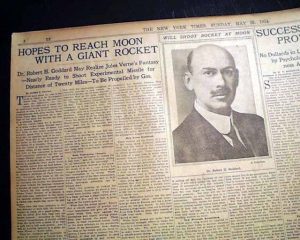It Happened on
January 13, 1920
In an infamous editorial, *The New York Times* once ridiculed American rocketry pioneer Robert H. Goddard for his claim that a rocket fired from Earth could reach the Moon by traveling through the vacuum of space. The newspaper argued that once a rocket left the Earth’s atmosphere, its flight would neither be accelerated nor maintained by the explosion of its fuel. The writer even suggested that to believe otherwise would be to deny basic laws of physics, sarcastically implying that only Dr. Einstein and a select few were capable of such feats.
The editorial further mocked Goddard’s credentials, stating that “Professor Goddard, with his ‘chair’ at Clark College and the endorsement of the Smithsonian Institution, does not know the relation of action to reaction, or the need for something more substantial than a vacuum to react against.” The piece concluded with a jab, suggesting Goddard lacked knowledge that was commonly taught in high school science classes.
Years later, on July 17, 1969, following the successful launch of Apollo 11, *The New York Times* retracted the 1920 editorial, admitting its mistake. The paper acknowledged that “it is now definitely established that a rocket can function in a vacuum as in an atmosphere,” and expressed regret for the error.
This episode remains a memorable lesson in the importance of scientific vision and perseverance, as well as a humbling reminder that even respected institutions can be wrong.

